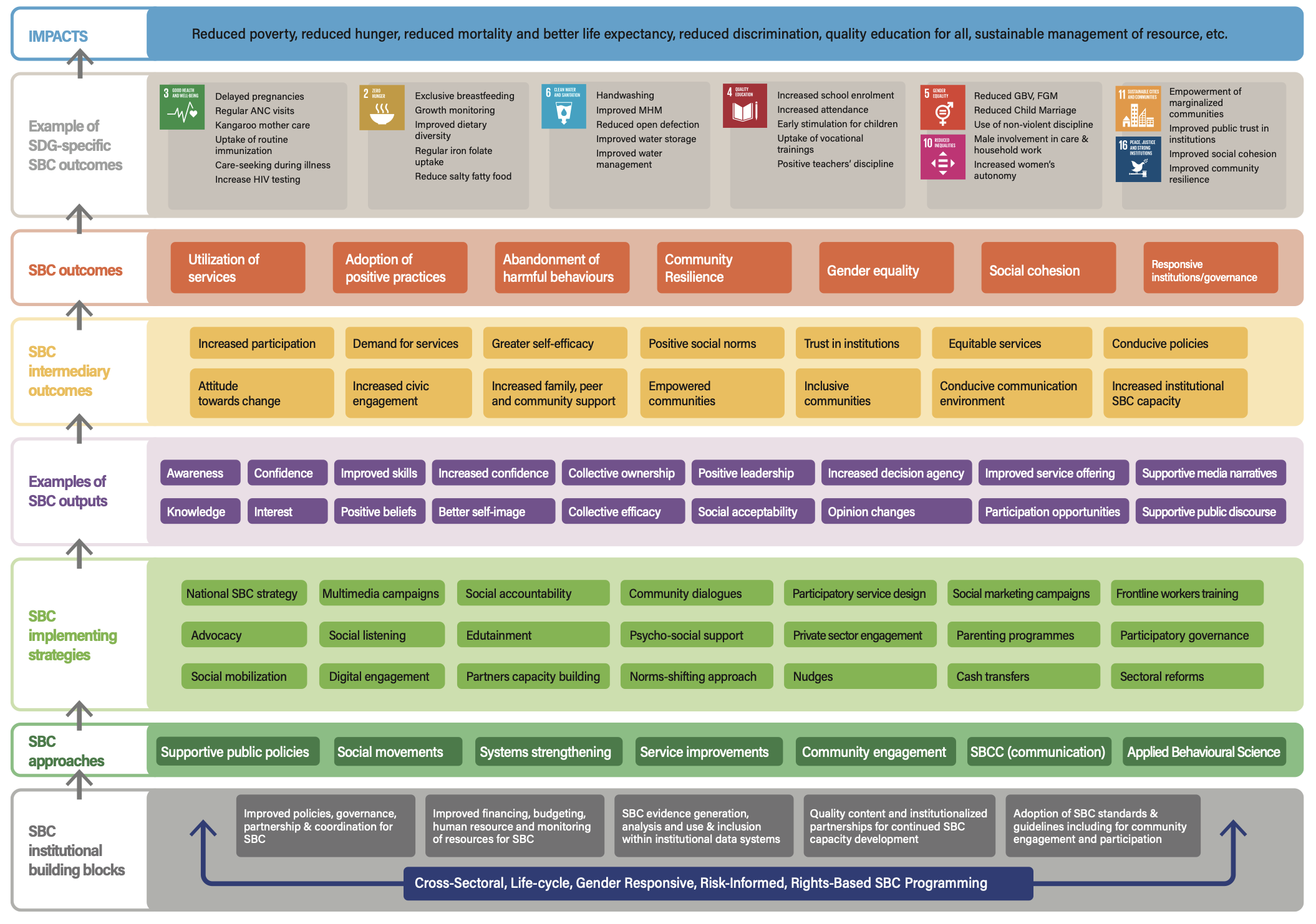
Selecting Results
How to build your Theory of Change and Results Framework
Introduction
Historically, the field of social and behaviour change has placed a lot of emphasis on activity-level metrics (such as the number of people reached by communication products), individual cognitive results (such as knowledge and awareness) and the prevalence of behaviours.
In recent years, the way behaviour change is measured has evolved to focus more on sophisticated measures of intermediate change, such as attitudes, self-efficacy, social acceptability and social norms. This reflects a growing interest in the impact of social phenomena on rights fulfilment, power imbalances and gender inequality.
The SBC Theory of Change detailed below shows the links between results at multiple levels and how SBC outcomes translate across different programming areas and Sustainable Development Goals (SDGs). This can be applied to both development programming and emergency contexts. See the M&E in Emergencies tool for more information on measuring outcomes in humanitarian contexts.
Types of SBC results
SBC interventions and results contribute to the achievement of sectoral goals and positive transformations across sectors and throughout society (equity, social cohesion, etc). SBC results generally fall into one of two categories: behavioural and social changes, or performance monitoring. Performance monitoring tracks how well strategies and interventions are being implemented.
An SBC results chain includes:
Outcomes
| Outcome-level results and indicators often refer to behavioural prevalence/incidence, such as the adoption or abandonment of certain practices, or positive social transformations, such as increased community resilience. These societal or behavioural results are partly due to the successful implementation of SBC strategies and activities. |
|---|---|
Intermediate Outcomes | Intermediate outcomes are precursors to the outcomes and milestones met on the way to the desired change. They include results at the individual (e.g. self-efficacy), collective (community dynamics and social norms) and institutional (access to equitable services) level. |
Outputs | Outputs are the low level results most directly linked to the SBC activities. They can be achieved and measured in a shorter period of time, can be attributed more closely to the programme, and are essential steps towards the intermediate outcomes. They also include results at the individual (e.g. knowledge and awareness), collective (ownership of the change effort) and institutional (more participation opportunities) level. |
Activities | The success of SBC activities and strategies can be measured in terms of information provided, stakeholders mobilized, communities engaged in a change process, local governance mechanisms strengthened etc. |
Theory of Change
A Theory of Change (TOC) outlines exactly how the results of a specific approach or activity contribute to achieving your desired outcomes. It links the elements of your SBC strategy and gives life to the evidence you collected and analysed. The outcomes of the TOC should reflect the problem statements. The intermediate outcomes and outputs should describe the bottlenecks and drivers that surfaced during the diagnosis and the opportunity statement should drive the selected activities.
A TOC lays out the logic of your overall strategy. You can share it with partners, and socialize it with communities and reference groups. If collaborators find issues with the pathway you have defined, you should work with them to improve the diagnosis, find gaps in the causal analysis and rethink the selected approaches and interventions.
A TOC is also an important communication and accountability tool, foundational to developing an M&E framework to track results. It highlights systems-related requirements for achieving results and can be used to advocate for financial and technical investments.
Developing a TOC
SBC programming begins with an analysis of socio-behavioural drivers and bottlenecks within institutions and systems (see Collecting social and behavioural evidence and other tools in the Diagnosis section). This analysis allows you to define results and select approaches and activities that effectively address the desired change that have been identified together with the appropriate rights holders and duty bearers.
Behaviours are driven by a range of influences at multiple levels, as shown in the Socio-Ecological Model and Behavioural Drivers Model. For any one behaviour, determining the high-priority drivers, how they relate to one another and which are most likely to shift is critical. Causal analysis of the root causes will help you identify priority drivers and the SBC approaches most likely to achieve the desired change. This will also inform the results chain and the selection of indicators at each level.
Participatory approaches and techniques such as human-centred design (HCD) can enhance the voices of communities and marginalized groups at all stages of evidence collection, analysis and utilization. These efforts strengthen the development of the TOC and corresponding results framework.
You can find examples of TOCs in UNICEF's Results Based Management (RBM) handbook, and through online resources from organizations like Girls Not Brides. The language and structure may vary, but the logic remains the same. A TOC should always be specific to your strategy and context. Your TOCs will likely include both behaviour change and social change elements.
The diagram below presents a generic TOC and the building blocks needed to ensure quality SBC interventions. It provides different SBC inputs and results, as well as examples of SDG-specific SBC outcomes. Keep in mind that the following is not exhaustive and represents a fraction of possible inputs and results.

Results framework
Each element of your TOC should relate to at least one properly formulated result, and provide metrics to measure it. A result statement should include a measurable change that results from a particular action. Indicators should be relevant to the implementation context and account for practical considerations such as feasibility of data collection and analysis.
Result statements should:
- Relate to the situational analysis - results should be derived from formative research and casual analysis
- Provide clarity regarding at each level - activity, output, intermediate outcome, outcome or impact
- Offer SMARTER results – Strategic, Measurable, Aligned, Realistic, Transformative, Empowering, Reportable
- Present a coherent results chain - results should be logically linked in a connected hierarchy
- Consider equity, human rights, gender, determinants and risks
The table below provides examples of results statements and corresponding indicators at multiple levels.
Result
| Outcome indicator
|
|---|---|
Result |
Intermediate Outcome indicator |
Result Pregnant women know the advantages of attending ANC visits | Output indicator |
Result Mechanisms are in place to engage parents around the importance of ANC | Activity indicator |
SBC programme materials and indicator sets can provide recommended and validated indicators with methodological guidance for measurement. UNICEF has developed a menu of SBC indicators within and across sectors. It is currently only available to internal staff, but will be available to all on this page and platform soon.
Online resources like Grassroots International and CFSC provide resources that specialise in social change.
Measuring community engagement
Community engagement is a critical and transformational aspect of SBC that requires particular attention during monitoring to ensure that standardized measures are being used to assess results. Community Engagement (CE) Minimum Quality Standards and Indicators is a guide to establishing an enabling environment and ensuring that intentional and structured CE remains at the core of sustainable development. This newly-developed inter-agency guidance suggests indicators for governments and partner/implementing agencies, and provides a checklist to guide CE planning at every stage of the project cycle.
For more information on measuring community engagement in emergency response, check out the M&E in emergencies tool.
For more information on building an efficient and dynamic strategy, check out the iterative programming tool.

Create - Selecting Results
Download this article as a PDF
You can download the entire page as a PDF here





